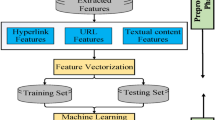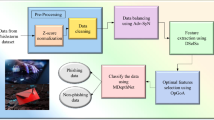Abstract
Cyber attackers target unconscious users with phishing methods is a serious threat to cyber security. It is important to quickly detect benign web pages according to legitimate ones. Despite the successful detection of phishing in the studies suggested in the literature, the problems of high false positive rate after the web page request is processed should be resolved. The novelty of the study is that classification of deep-hybrid features with the Light Gradient Boosted Machine model is evaluated as an event when the web address is entered on the address bar of the browser. Thus, phishing can be detected at every request entry before the process is completed. In the proposed approach, normalized features from requests of web pages are applied to Sparse Autoencoder and Principal Component Analysis methods. These methods contribute to encoding of the deep-hybrid feature extraction. Light Gradient Boosted Machine model classifier can effectively distinguish legitimate pages and phishing attacks using these features. The ISCX-URL phishing dataset is used to measure performance of the proposed approach and validate it. The proposed method classifies the features that are encoded with SAE-PCA by using the Light Gradient Boosted Machine model at the rate of 99.6% within the event. The obtained results show that the proposed approach performs better classification performance metrics than most others. This accuracy contributed to the solution of the false-positives problem before requests are processed compared to other models.





Similar content being viewed by others
References
Demirci, S., Demirci, M., & Sagiroglu, S. (2019). Virtual security functions and their placement in software defined networks: A survey. Gazi University Journal of Science, 32(3), 833–851
Basit, A., Zafar, M., Liu, X., Javed, A. R., Jalil, Z., & Kifayat, K. (2020). A comprehensive survey of AI-enabled phishing attacks detection techniques. Telecommunication Systems, 1–16.
El Aassal, A., Baki, S., Das, A., & Verma, R. M. (2020). An in-depth benchmarking and evaluation of phishing detection research for security needs. IEEE Access, 8, 22170–22192
Ferrag, M. A., Maglaras, L., Moschoyiannis, S., & Janicke, H. (2020). Deep learning for cyber security intrusion detection: Approaches, datasets, and comparative study. Journal of Information Security and Applications., 50, 102419
Harinahalli Lokesh, G., & BoreGowda, G. (2020). Phishing website detection based on effective machine learning approach. Journal of Cyber Security Technology, 1–14.
APWG Report, (2019). Phishing Activity Trends Report, Retrieved September 7, 2020, from https://docs.apwg.org/reports/apwg_trends_report_q3_2019.pdf
Banu, R., Anand, M., Kamath, A., Ashika, S., Ujwala, H. S., & Harshitha, S. N. (2019). Detecting phishing attacks using natural language processing and machine learning. In 2019 International Conference on Intelligent Computing and Control Systems (ICCS) (pp. 1210–1214).
Rao, R. S., Vaishnavi, T., & Pais, A. R. (2020). CatchPhish: detection of phishing websites by inspecting URLs. Journal of Ambient Intelligence and Humanized Computing, 11(2), 813–825
Ali, W., & Ahmed, A. A. (2019). Hybrid intelligent phishing website prediction using deep neural networks with genetic algorithm-based feature selection and weighting. IET Information Security, 13(6), 659–669
Han, W., Cao, Y., Bertino, E., & Yong, J. (2012). Using automated individual white-list to protect web digital identities. Expert Systems with Applications, 39(15), 11861–11869
Jain, A. K., & Gupta, B. B. (2016). A novel approach to protect against phishing attacks at client side using auto-updated white-list. EURASIP Journal on Information Security, 2016(1), 1–11
Ravi, R., & Raja, E. (2020). A performance analysis of Software Defined Network based prevention on phishing attack in cyberspace using a deep machine learning with CANTINA approach (DMLCA). Computer Communications, 153, 375–381
Cao, Y., Han, W., & Le, Y. (2008, October). Anti-phishing based on automated individual white-list. In Proceedings of the 4th ACM workshop on Digital identity management (pp. 51–60).
Mohammad, R. M., Thabtah, F., & McCluskey, L. (2014). Intelligent rule-based phishing websites classification. IET Information Security, 8(3), 153–160
Li, T., Kou, G., & Peng, Y. (2020). Improving malicious URLs detection via feature engineering: Linear and nonlinear space transformation methods. Information Systems., 91, 101494
Sahingoz, O. K., Buber, E., Demir, O., & Diri, B. (2019). Machine learning based phishing detection from URLs. Expert Systems with Applications, 117, 345–357
Chiew, K. L., Tan, C. L., Wong, K., Yong, K. S., & Tiong, W. K. (2019). A new hybrid ensemble feature selection framework for machine learning-based phishing detection system. Information Sciences, 484, 153–166
Xiang, G., Hong, J., Rose, C. P., & Cranor, L. (2011). Cantina+ a feature-rich machine learning framework for detecting phishing web sites. ACM Transactions on Information and System Security (TISSEC), 14(2), 1–28
He, M., Horng, S. J., Fan, P., Khan, M. K., Run, R. S., Lai, J. L., & Sutanto, A. (2011). An efficient phishing webpage detector. Expert systems with applications, 38(10), 12018–12027
Marchal, S., François, J., State, R., & Engel, T. (2014). PhishScore: Hacking phishers' minds. In 10th International Conference on Network and Service Management (CNSM) and Workshop, IEEE (pp. 46–54).
Gowtham, R., & Krishnamurthi, I. (2014). A comprehensive and efficacious architecture for detecting phishing webpages. Computers and Security, 40, 23–37
Babagoli, M., Aghababa, M. P., & Solouk, V. (2019). Heuristic nonlinear regression strategy for detecting phishing websites. Soft Computing, 23(12), 4315–4327
Mohammad, R. M., Thabtah, F., & McCluskey, L. (2014). Predicting phishing websites based on self-structuring neural network. Neural Computing and Applications, 25(2), 443–458
Jain, A. K., & Gupta, B. B. (2018). Towards detection of phishing websites on client-side using machine learning based approach. Telecommunication Systems, 68(4), 687–700
Feng, F., Zhou, Q., Shen, Z., Yang, X., Han, L., & Wang, J. (2018). The application of a novel neural network in the detection of phishing websites. Journal of Ambient Intelligence and Humanized Computing, 1–15.
Bozkir, A. S., & Aydos, M. (2020). LogoSENSE: A Companion HOG based logo detection scheme for phishing web page and e-mail brand recognition. Computers and Security, 101855.
Powell, A., Bates, D., Van Wyk, C., & de Abreu, D. (2019). A cross-comparison of feature selection algorithms on multiple cyber security data-sets. In FAIR (pp. 196–207).
Wei, W., Ke, Q., Nowak, J., Korytkowski, M., Scherer, R., & Woźniak, M. (2020). Accurate and fast URL phishing detector: A convolutional neural network approach. Computer Networks, 107275.
Bahnsen, A. C., Bohorquez, E. C., Villegas, S., Vargas, J., & González, F. A. (2017, April). Classifying phishing URLs using recurrent neural networks. In 2017 APWG symposium on electronic crime research (eCrime) (pp. 1–8).
Zhang, J., & Li, X. (2017, December). Phishing detection method based on borderline-smote deep belief network. In International Conference on Security, Privacy and Anonymity in Computation, Communication and Storage (pp. 45–53). Cham:Springer.
Yang, P., Zhao, G., & Zeng, P. (2019). Phishing website detection based on multidimensional features driven by deep learning. IEEE Access, 7, 15196–15209
Uçar E., İncetaş M., Mürsel O., (2019). A Deep learning approach for detection of malicious URLs. In 6th International Management Information Systems Conference, (pp.12–20).
Mamun, M. S. I., Rathore, M. A., Lashkari, A. H., Stakhanova, N., & Ghorbani, A. A. (2016, September). Detecting malicious urls using lexical analysis. In International Conference on Network and System Security (pp. 467–482).
Aburomman, A. A., & Reaz, M. B. I. (2016, October). Ensemble of binary SVM classifiers based on PCA and LDA feature extraction for intrusion detection. In 2016 IEEE Advanced Information Management, Communicates, Electronic and Automation Control Conference (IMCEC) (pp. 636–640).
Kim, S., Jo, W., & Shon, T. (2020). APAD: autoencoder-based payload anomaly detection for industrial IoE. Applied Soft Computing., 88, 106017
Ke, G., Meng, Q., Finley, T., Wang, T., Chen, W., Ma, W., & Liu, T. Y. (2017). Lightgbm: A highly efficient gradient boosting decision tree. Advances in neural information processing systems, 30, 3146–3154
Mamun, M. S. I., Rathore, M. A., Lashkari, A. H., Stakhanova, N., & Ghorbani, A. A (2016). ISCX-URL2016 Dataset. Retrieved May 10, 2020 from https://www.unb.ca/cic/datasets/url-2016.html
Li, Y., Yang, Z., Chen, X., Yuan, H., & Liu, W. (2019). A stacking model using URL and HTML features for phishing webpage detection. Future Generation Computer Systems, 94, 27–39
Funding
This work was not funded by any organization.
Author information
Authors and Affiliations
Corresponding author
Ethics declarations
Conflict of interest
The authors declare that they have no conflict of interest.
Ethical approval
This article does not contain any studies with human participants or animals performed by any of the authors.
Additional information
Publisher's Note
Springer Nature remains neutral with regard to jurisdictional claims in published maps and institutional affiliations.
Appendix
Appendix
1.1 The experimental results of compared method with TP, FP, FN and TN metrics
The TP, FP, FN and TN of compared methods.
Methods | TP | FP | TN | FN |
|---|---|---|---|---|
CNN-LSTM | 1380 | 36 | 1524 | 38 |
LightGBM (ISCX) | 1399 | 17 | 1540 | 22 |
LightGBM (SAE) | 1375 | 41 | 1515 | 47 |
LightGBM (PCA) | 1387 | 29 | 1523 | 39 |
SVM (ISCX) | 1363 | 53 | 1530 | 32 |
SVM (SAE) | 1345 | 71 | 1507 | 55 |
SVM (PCA) | 1380 | 38 | 1512 | 48 |
MLP (ISCX) | 1353 | 63 | 1518 | 42 |
MLP (SAE) | 1354 | 62 | 1518 | 44 |
MLP(PCA) | 1369 | 47 | 1514 | 48 |
Proposed SAE and PCA with LightGBM | 1407 | 9 | 1559 | 3 |
Rights and permissions
About this article
Cite this article
Kasim, Ö. Automatic detection of phishing pages with event-based request processing, deep-hybrid feature extraction and light gradient boosted machine model. Telecommun Syst 78, 103–115 (2021). https://doi.org/10.1007/s11235-021-00799-6
Accepted:
Published:
Issue Date:
DOI: https://doi.org/10.1007/s11235-021-00799-6




